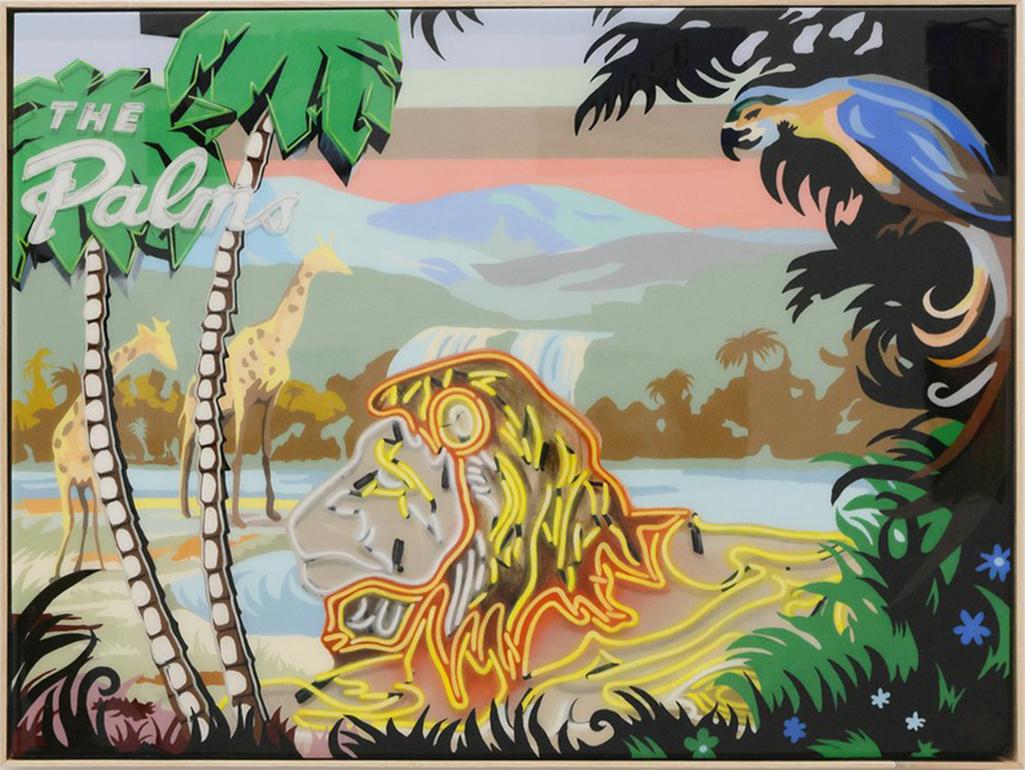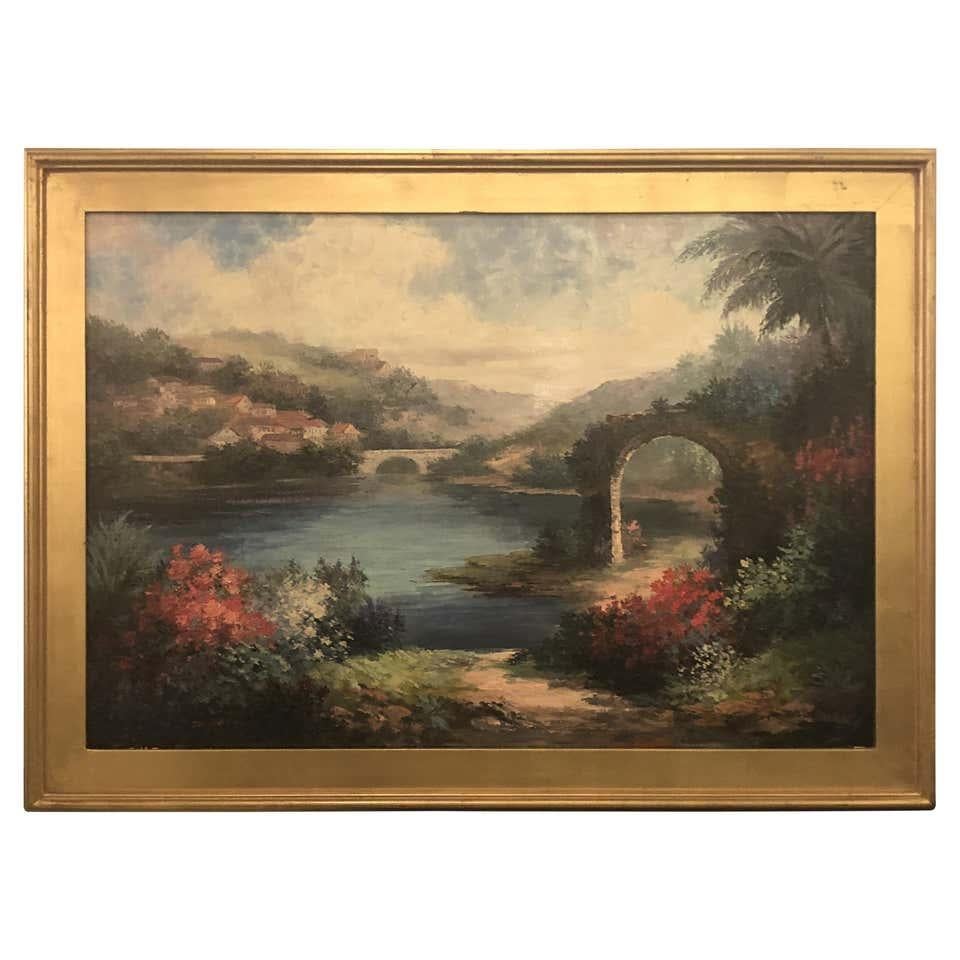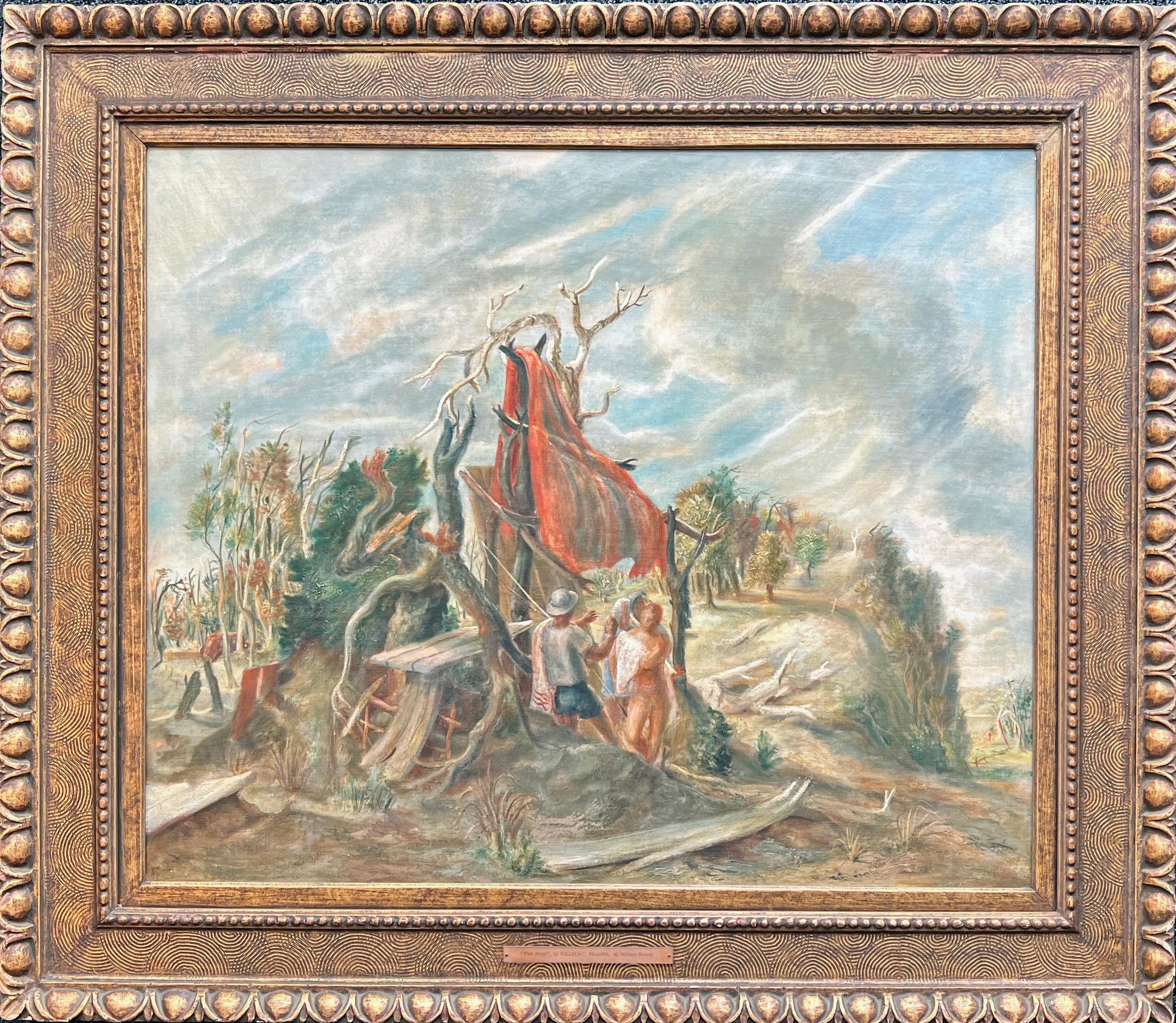Items Similar to Gospel Hall, Calais, VT
Want more images or videos?
Request additional images or videos from the seller
1 of 4
Harold HaydonGospel Hall, Calais, VT1940
1940
About the Item
A "Thumb Box" (diminutive) painting of the Gospel Hall in Calais, VT by Harold Haydon.
Harold Emerson Haydon was born in Fort William, Ontario, Canada in 1909. Haydon came to Chicago with his family in 1917 and became a naturalized American citizen in 1941. He attended the University of Chicago Lab School and the University of Chicago, where he earned a Bachelor’s Degree and Master’s Degree in Philosophy. He also studied painting at the Art Institute of Chicago. Haydon was a long-time Professor of Art at the University of Chicago, teaching from 1944-1975. He became an instructor at the Art Institute of Chicago from 1975-1981. Haydon also taught as an Adjunct Professor of Fine Arts at Indiana University from 1975-1982. In addition, Haydon served as the noted art critic of the Chicago Sun-Times from 1963-1985. He died in Chicago in 1994.
- Creator:Harold Haydon (1909 - 1994, American)
- Creation Year:1940
- Dimensions:Height: 4.5 in (11.43 cm)Width: 6 in (15.24 cm)
- More Editions & Sizes:Framed size: 9 3/4" x 10 3/4", Oil on paperPrice: $950
- Medium:
- Movement & Style:
- Period:
- Condition:
- Gallery Location:Chicago, IL
- Reference Number:1stDibs: LU2591212667282
About the Seller
No Reviews Yet
Vetted Seller
These experienced sellers undergo a comprehensive evaluation by our team of in-house experts.
Established in 2000
1stDibs seller since 2023
9 sales on 1stDibs
Typical response time: <1 hour
- ShippingRetrieving quote...Ships From: Chicago, IL
- Return PolicyThis item cannot be returned.
More From This SellerView All
- Untitled (Vineyard Harbor)By Francis ChapinLocated in Chicago, ILA colorful view of Martha's Vineyard by Francis Chapin, from the 1930s. Francis Chapin, affectionately called the “Dean of Chicago Painters” by his colleagues, was one of the city’s most popular and celebrated painters in his day. Born at the dawn of the 20th Century in Bristolville, Ohio, Chapin graduated from Washington & Jefferson College near Pittsburgh, Pennsylvania before enrolling at the Art Institute of Chicago in 1922. He would set down deep roots at the Art Institute of Chicago, exhibiting there over 31 times between 1926 and 1951. In 1927 Chapin won the prestigious Bryan Lathrop Fellowship from the Art Institute – a prize that funded the artist’s yearlong study trip to Europe. Upon his return to the United States, Chapin decided to remain in Chicago, noting the freedom Chicago artists have in developing independently of the pressure to conform to pre-existing molds (as was experienced by artists in New York, for example). Chapin became a popular instructor at the Art Institute, teaching there from 1929 to 1947 and at the Art Institute’s summer art school in Saugatuck, Michigan (now called Oxbow) between 1934 – 1938 (he was the director of the school from 1941-1945). A prolific painter, Chapin produced numerous works while traveling in Mexico, France, Spain, Saugatuck and Martha’s Vineyard, where he frequently spent summers and taught at the Old Sculpin Gallery there. Chapin was best recognized for his dynamic and vibrant images of Chicago during the 1930s and 40s. Chapin was a resident of the Old Town neighborhood where he lived and kept his studio on Menomonee Street for many years. Described as a “colorful figure, nearly 6 feet 6 inches tall, and thin, and usually wearing tweeds”, it is easy to imagine Chapin at work observing the busy street life of the city. In addition to his many exhibitions at the Art Institute of Chicago, Chapin’s work was shown during his lifetime at such institutions as the Pennsylvania Academy of Fine Arts, Philadelphia; the Corcoran Gallery, Washington, D.C.; the National Academy of Design, New York; the Museum of Modern Art, New York; the Whitney Museum of American Art, New York and the Carnegie Institute, Pittsburgh, among others. Francis Chapin’s paintings are represented in the collections the Art Institute of Chicago; the Friedman Collection, Chicago; the Butler Institute of American Art, Youngstown; the Denver Art Museum; the Everson Museum of Art, Syracuse; the Norton Museum of Art, West Palm Beach...Category
1930s American Modern Landscape Paintings
MaterialsMasonite, Oil
- Untitled (Martha’s Vineyard)By Francis ChapinLocated in Chicago, ILA colorful view of Martha's Vineyard (Depicting Edgartown's main street) by Francis Chapin, from around 1950. Francis Chapin, affectionately called the “Dean of Chicago Painters” by...Category
1950s American Modern Landscape Paintings
MaterialsMasonite, Oil
- Oak Bluffs, Mass. (Martha’s Vineyard)By Francis ChapinLocated in Chicago, ILA view of Oak Bluffs, MA on Martha's Vineyard by Francis Chapin, from around 1950. Francis Chapin, affectionately called the “Dean of Chicago Painters” by his colleagues, was one of...Category
1950s American Modern Landscape Paintings
MaterialsMasonite, Oil
- Western View from Sun Deck on Ajax Mt, Aspen, Colo.By Harold HaydonLocated in Chicago, ILA small, colorful Modernist landscape painting by Harold Haydon, depicting "Western View from Sun Deck on Ajax Mt., Aspen, Colo.", dated 1955. This pain...Category
1950s American Modern Landscape Paintings
MaterialsOil
- Vermont LandscapeBy Harold HaydonLocated in Chicago, ILA "Thumb Box" (Diminutive) painting of Vermont by Harold Haydon. Harold Emerson Haydon was born in Fort William, Ontario, Canada in 1909. Haydon came ...Category
1940s American Modern Landscape Paintings
MaterialsOil
- Nantucket SteamerBy Francis ChapinLocated in Chicago, ILA gem of a painting depicting a Nantucket lighthouse by Francis Chapin, from around 1950. Francis Chapin, affectionately called the “Dean of Chicago Painters” by his colleagues, was...Category
1950s American Modern Landscape Paintings
MaterialsOil, Board
You May Also Like
- Flocks of housesBy FPA Francis Pavy ArtistLocated in Lafayette, LAThis small work, entitled flocks of houses measures 7 inches tall by 5 inches wide. It is oil on canvas on wood sketchers. It's signed on the reverse. The writing on the reverse rea...Category
Early 2000s American Modern Landscape Paintings
MaterialsOil
- Who's the king?Located in Nashville, TNMelissa Sims’ work utilizes motifs from collage and pop art, in that several different images are combined into one cohesive but surreal landscape. Sims c...Category
2010s American Modern Animal Paintings
MaterialsResin, Oil, Acrylic
- Americana Landscape Oil on Canvas Painting Signed P. Paul, FramedLocated in Plainview, NYAn elegant oil on canvas landscape painting featuring a lake view in a paradisiac environment. The painting is finely framed in custom giltwood frame. A wonderful addition to any liv...Category
1980s American Modern Landscape Paintings
MaterialsOil, Canvas
- Amish Farmscape #3By Edmund LewandowskiLocated in Los Angeles, CAAmish Farmscape #3, 1984, oil on canvas, 40 x 30 inches, signed and dated lower right; signed, dated, and titled verso About the Painting Amish Farmscape #3 is part of a multi-painting series of barns completed in the early 1980s for an exhibition at New York’s prestigious Sid Deutsch Gallery. Lewandowski painted this work at an important point in his career. It was the first major project undertaken by Lewandowski after his retirement from serving as the Chairman of Winthrop University’s Art Department, the last academic position he held after teaching for nearly thirty years. Lewandowski had been inspired to work on the series by a visit to Lancaster County, Pennsylvania. Like his friend and mentor, Charles Sheeler, Lewandowski had always been fascinated by vernacular architecture and the Amish barns of Pennsylvania brought back memories of rural scenes Lewandowski had painted in the Midwest much earlier in his career. Amish Farmscape #3 is a strong example of Lewandowski’s late precisionist work. The complexity of the composition and Lewandowski’s technical acumen are on full display. Being relieved of the burdens of teaching and administering a university art department likely allowed Lewandowski greater freedom and most importantly more time to complete the Amish Farmscape series. Although Lewandowski’s brand of precisionism changed throughout the years, he never deviated from the core tenets of the Immaculate School artists. In this work, we see simplified and flattened forms, the use of ray-lines to define light and space, the elimination of extraneous details, a polished almost machine-like finish, and the complete lack of visible brushstrokes, all hallmarks of the precisionist painters. Lewandowski was the last of the 20th century precisionists and in Amish Farmscape #3, we see just how successfully he continued to work in this style until his death in 1998. About the Artist Edmund Lewandowski was among the best of the second-generation precisionist painters. He was born and raised in Milwaukee, Wisconsin and studied at the Layton School of Art with Garrett Sinclair. Lewandowski achieved early success when in 1936 two of his watercolors were shown at the Phillips Collection as part of a Federal Art Project exhibition. Then, in 1937, his work was first exhibited at Edith Halpert’s Downtown Gallery which represented Lewandowski into the 1950s. Under Halpert’s guidance, Lewandowski continued to explore watercolor as his main medium during the 1930s and 1940s, since the gallery already represented Charles Sheeler, who worked primarily in oils. Sheeler became Lewandowski’s major influence as the primary leader of the ill-defined, but very recognizable Immaculate School artists, which included other Downtown Gallery painters, Niles Spencer, George Ault, and Ralston Crawford, as well as Charles Demuth and Preston Dickinson, both of whom died at a young age and had been represented by the Charles Daniel Gallery. Sheeler is credited with giving Lewandowski technical advice on how to make his paintings more precise and tightly rendered and by all accounts, Sheeler was a fan of Lewandowski’s work. Through the Downtown Gallery, Lewandowski’s paintings were accepted into major national and international exhibitions and purchased by significant museums and collectors. Franklin and Eleanor Roosevelt and Nelson Rockefeller acquired works by Lewandowski. He was included in the Museum of Modern Art’s important 1943 exhibition, American Realists and Magic Realists as well as juried exhibitions at the Whitney Museum of American Art, the Pennsylvania Academy of Fine Arts, and the Art Institute of Chicago. Lewandowski also completed commissions for magazines during the 1940s and 1950s, including several covers for Fortune. Throughout his career, Lewandowski explored urban and rural architecture, industry, machinery, and nautical themes. Looking back on his career, Lewandowski wrote, “My overwhelming desire as an artist through the years has been to record the beauty of man-made objects and energy of American industry on canvas. For as far back as I can recall, the cityscapes, farms and depictions of industrial power and technological efficiency has had a great attraction for me. I try to treat these observations with personal honesty and distill these impressions to a visual order.” Lewandowski is credited with extending precisionism to the Midwest and successfully continuing the style into the 1990s, three decades after Sheeler’s death and six decades after Demuth’s passing. Late in his career, Lewandowski enjoyed a resurgence of popularity as he was represented during the 1980s by New York’s Sid Deutsch and Allison Galleries...Category
Mid-20th Century American Modern Landscape Paintings
MaterialsCanvas, Oil
- Southern California Foothills oil by Anni BaldaughLocated in Hudson, NYCanvas measures 24" x 30" and framed 30" x 36" x 3" About this artist: Anni Baldaugh was the daughter of Anthonius Hendricus Schade van Westrum. With a father who was a naval officer, the van Westrum family spent significant amounts of time in the Dutch East Indies. After returning to Europe, Baldaugh studied art with various teachers in Vienna, Munich and Paris. She and her husband ended up living in Los Angeles, though they suffered financial losses during World War I. While in Los Angeles, Baldaugh joined the California Watercolor Club, the California Society of Miniature Painters, the Bookplate Association International, the Laguna Beach Art Association, and the San Diego Fine Arts Society. She also became a member of the Connecticut Academy of Fine Arts. During the Great Depression...Category
1930s American Modern Landscape Paintings
MaterialsOil, Canvas
- Fish Story oil painting by Williams Charles PalmerLocated in Hudson, NYThis painting is illustrated in the Catalogue of the 1945 Encyclopedia Britannica Collection of Contemporary American Painting, p.84. Written and edited by Grace Pagano. "Painting ...Category
Mid-20th Century American Modern Figurative Paintings
MaterialsOil, Canvas
Recently Viewed
View AllMore Ways To Browse
Lab Painting
Harold Haydon
Mid Century American Painting
Early Impressionist Paintings
Vintage Painting Light
Oil Canvas Small
Vintage Sign Collectors
Vintage Oil On Board
Paintings By Charles
Vintage Oil On Board Paintings
Vintage Oil Painting On Board Paintings
Vintage Paris Oil Painting
Gilt Frame With Art
Oil Shipping
Green Landscape Oil Painting
Vintage Salon Art
Expressive Landscapes
American War Painting




